Inspired by lots interesting compositions of the Moon together with the landscape of Earth, I decided to give it a try myself.
I had an idea of the Danish Royal Hunting Lodge in Dyrehaven North of Copenhagen in front of the huge rising Moon – but I didn’t know if it was possible to shoot it or how to plan it – so I set out on a quest to learn something new within photography!
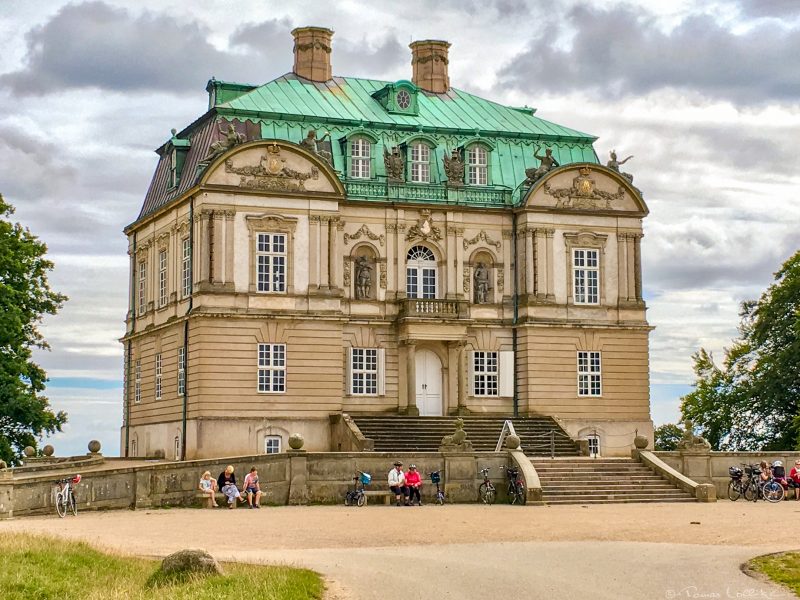
The Danish Royal Hunting Lodge
My prerequisites were primarily that I had a camera and a zoom lens and an unsteady tripod!
Also I knew this:
If you zoom in on objects being behind each other, then the object the farthest away becomes relatively larger than the object in front – more so the farther apart the two objects are spread apart!
I knew I had to be as far away from the castle as possible, but within clear sight from it – and within the limits of my zoom lens, of course.
I also knew that the Moon – like the Sun – rises in the east and sets in the west.
So I had to find a spot in westerly direction from the castle (to get a Moonrise in the east) or in easterly direction from the castle (to get a Moonset in the west) – and with no obstacles between me and the castle or between the castle and the path of the Moon.
Luckily there is about 1-2 km of clear and almost treeless view to both the East and West of the castle – but with woods both to the North and South of it.
- The Eremitage Plain to the East of the castle
- The Eremitage Plain to the West of the castle
There were three things I remained to investigate:
- The potential terrain variations on these plains – were there any small hills in the landscape that could come in my line if sight?
- Where exactly in the sky would the Full Moon be – and when?
- How big would the Moon appear compared to the castle
I knew that that depended of my distance to the castle and the zoom factor – but I didn’t know the specific details.
To the fist question, I already knew, that from the castle and to the East there’s a gentle and steady fall in terrain until the sea about a little more than a 1 km away but with the railway line crossing a little less than 1 km away.
To the West of the castle the perimeter is about 1,5-2 km away and the area with open land is wider, but there are multiple terrain variations as well as small groves of trees spread out all over. I had to investigate these closer to get a better understanding of my possibilities – so I went out there scouting a few days prior to the upcoming Full Moon!
Before heading out, I had taken some pictures of the Moon from home, and had found out that even with my 300mm zoom lens the Moon didn’t fill out as much of the frame as I had hoped for – but it did when I photographed it through my small telescope! 🔭
So I borrowed a kids trolley from my brother and brought the telescope with me to Dyrehaven one afternoon.
It did draw some attention, strolling on the plains of Dyrehaven with a night sky telescope in the middle of a cloudy afternoon 😂
Unfortunately the perimeter of the plain to the west of the castle didn’t have as clear a view as I had hoped for – actually I couldn’t even see the castle from the entrance due to a hill – so I went to the top of the hill, but there were yet another (smaller) hill in the way, so I went to the top of that hill – and then the line of sight was clear!!
So I packed out and setup my telescope there – still in the middle of the day – and took a picture of the castle from the top of that hill.
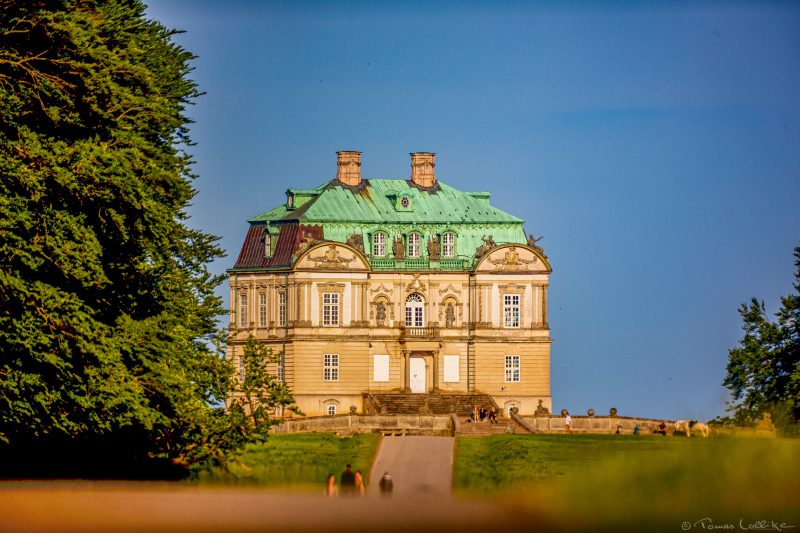
The Danish Royal Hunting Lodge from 950 m through my DSLR camera mounted on the 650mm telescope
As you can see in the photo above, there were actually still yet another hill some couple of hundred meters in front of me. I didn’t want to go to the next hill, as my plan was to stay as far away from the castle as possible, and then get near it by zooming – to get that effect with the large Moon I was in the hunt for. To the left of the road is one of the aforementioned tree groves.
Before moving on, I took the same photo with phone to have my geolocation stored, so I could later calculate the distance from that location to the castle (my DSLR camera doesn’t have GPS).
- Same castle from same spot as above but with iPhone (no zoom)
- Still same spot and iPhone but with max (digital) zoom
I later calculated the distance between the castle and my location to 950 meters – so that could potentially work – but didn’t like the hill in front of me and neither the trees to the left of the road, as they didn’t leave space for any manoeuvring, and there’s something wrong with the balance in the image too. The Moon could potentially rebalance the image, if in the air above and to the right of the castle – but I wanted the Moon behind the castle; not above it…!
Anyway, I still didn’t know the relation between the Moon and the castle, so I called it a day, and went home and played with my images in Photoshop.
At the first Full Moon after buying the telescope I had taken a Full Moon picture with both the same camera and the same telescope – so by combining that photo with the photos just taken of the castle, I would be able to get an approximation of the relative sizes. I then knew the answer to my third question; the relation between the sizes of the castle and the Moon!
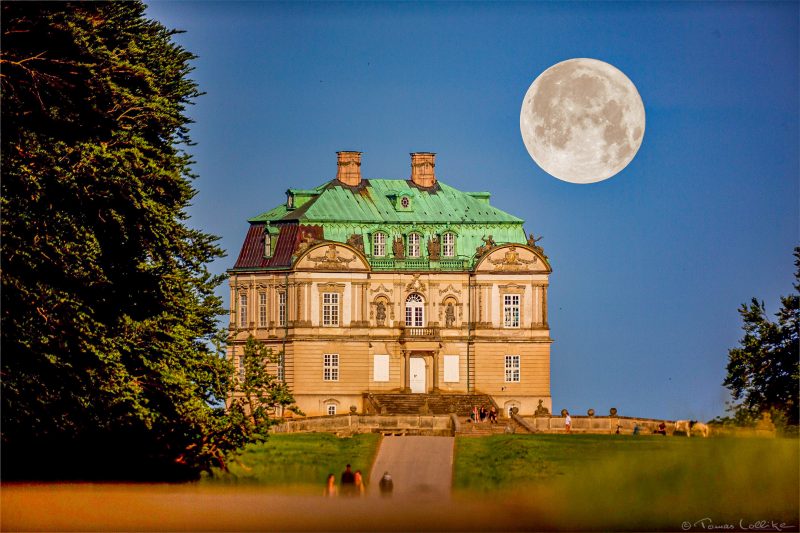
The Danish Royal Hunting Lodge from 950 m with the Moon added in Photoshop
I still needed to find the answers to he second question; when the Moon would be behind the castle (if ever) and whereto I would have to move, to get it in the position I wanted.
I had just heard about The Photographer’s Ephemeris and thought I’d give it a try – so I started out using their web version, but later downloaded it as an app to my phone too.
It turned out that I was never going to see the Moon behind the castle from that hill as it would rise to the right of the castle (seen from the road) and by the time it had reached the hight of the hill the castle located on, it would be way behind the woods to the right…
The Photographer’s Ephemeris could tell me, that if I moved as far north (left of the road) as possible, I could maybe get my shot of the Moon behind the castle.
This is how TPE works:
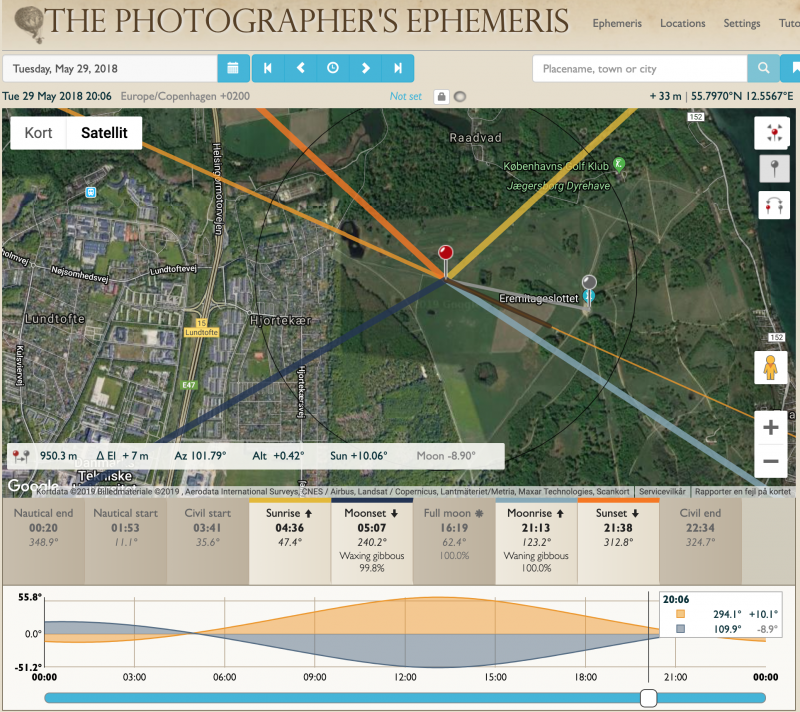
- Place the red pin where you are or want to be (you can search for a place at the top right).
In the above screenshot I have placed the red pin where I took the above trial pictures. - From the red pin 4 coloured thick lines will appear – and possibly some thinner lines too
In the above screenshot there are 2 orange/yellow thinner lines too (opposite to each other) - The yellow/orange thick lines are the directions of the Sunrise (yellow) and the Sunset (orange)
- The light-blue/dark-blue thick lines the directions of the Moonrise (light-blue) and Moonset (dark-blue).
- Set the desired date and time at the top left.
- By moving the slider at the bottom, thinner coloured lines will appear and/or disappear – these are the directions of the Sun and Moon at the time indicated by the slider at the bottom.
- Opposite to the Sun and Moon directions are even thinner lines indicating the direction of the shadows cast by the Sun and Moon respectively.
- You can also see on the slider in what azimuth direction (angular direction from North) the Sun/Moon are and their declination (angular elevation from horizon).
In the above case the Sun is nearing Sunset, and is 10,1º above horizon and thus it has started to cast elongated shadows.
The elongated shadows are indicated by the thin shadow-line of the Sun has begun to thicken and darken and getting longer as Sunset is nearing. When the thickening of the Sun’s shadow-line reaches the black circle, the circle will shine in Sun-yellow indicating that the Sun is 6º above horizon and thus the Golden Hour has begun (giving a very soft and warm light glow to your photos until Sunset). This is the last hour before Sunset. - I have placed a second (gray) pin on top of the castle.
This helps me to see both my elevation and the distance and altitude difference between the pins – as well as the azimuth direction from the red to the gray pin.
As you can see, the direction of the Moonrise, seen from the red pin, is way off to the south of the castle. - So I will have to move north – enough to make the azimuth line between the pins match the azimuth direction of the Moon at the desired time.
- So first I move the time to a little after Moonrise (to give the Moon time to rise enough to my likings), then I drag the red pin to a new location north, keeping an eye on the azimuth lines (thin light blue to the Moon and thin gray to the gray pin).
I keep dragging the red pin until these two azimuth lines are almost on top of each other.
And here it is – my new location – on the other side of the golf course!
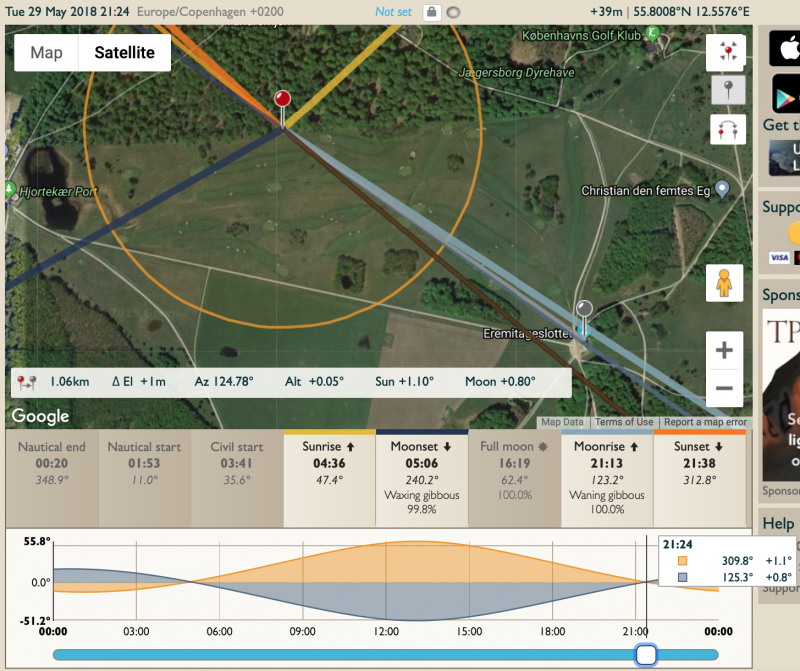
The Photographer’s Ephemeris
In the above screenshot the 2 azimuth lines are exactly on top of each other – and the Moon is 0,8º above horizon which I estimate to be enough. It also clear that at that time – 21:24 – the sun is also still above horizon, and thus should cast a nice redish glow on the Moon (which in itself will be red too because it’s so low above horizon). And finally important to note too, the red pin’s altitude is 39 meters and the grey pin’s altitude is +1 meter or +0,05º
Next step – in this case – were to go out again and to a little more scouting:
- Although I knew the red pin (my location) was a little lower than the grey pin (the castle), the elevation or altitude difference doesn’t tell if there are any obstacles between the pins (could be a mountain or in this case possibly hills or trees), so I had to head out there and check it visually.
- By going at the time of Moonrise I will also be able to check if the 0,8º declination of the Moon is enough or too much.
However the Moon doesn’t rise (or sets) the same place every day, so I will not be able to see if my azimuth calculation is correct – but it should be. - So I move the date to the day of scouting and checks the direction and time for the moon being at 0’8º above horizon – but it turned out that the Moon would rise behind the woods to the right of the castle that day, so I had to check that part elsewhere.
- I also found a lot of small rises and falls in the terrain between my desired location and the castle – so I moved around between the fareways trying to stay on the azimuth line that matched the rising of the Full Moon a few days later.
- Finally I decided to move all the way back into the tree-line of the woods, knowing I would be clipping the lowest part of the castle, but it was the best possibility for a location not too near the castle!
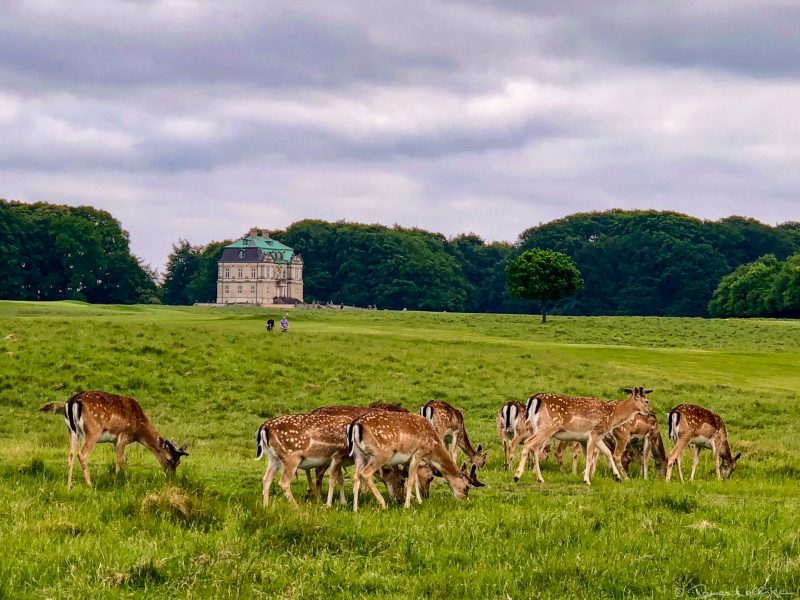
Sika deer enjoying the rough of the golf course (golfers in the background)
After I finally decided on my shooting spot, I checked the mobile app version of The Photographer’s Ephemeris – because it provides the possibility to simulate the upcoming situation in augmented reality (AR).
Below to the left is a screenshot of my phone with the Moon and it’s path above the castle approximately 25 min after it is expected to be visible over the horizon – and to the right is the actual Moon a few days later (but from a slight different position).
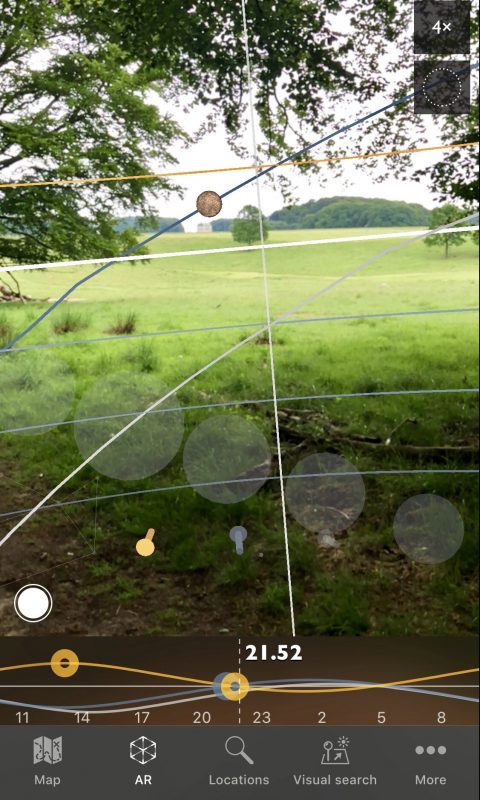
Moon overlay with TPE’s AR
to verify the expected path
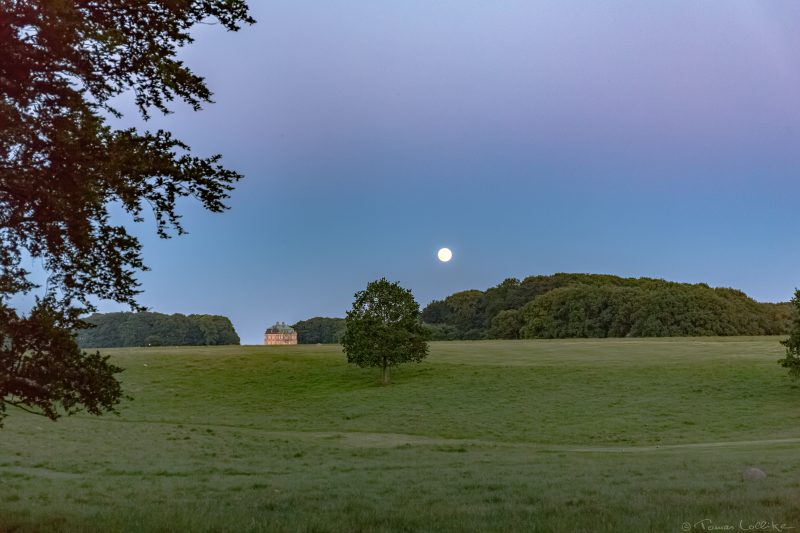
The real Moon for comparison with TPE’s AR (from a slightly different position though)
All that remained were to hope for good weather at the evening of the Full Moon and await the day! 🙂
On the evening of the planned Full Moon, I headed out to Dyrehaven well in advance to setup the equipment and do some final test shots.
- My location for the shooting – 1 km from the castle
- My setup with the 650mm telescope and a second camera with a 300mm lens
Finally the time of the Moon Rise uprose – at 21:13 – and nothing happened…!
I didn’t actually expect anything to happen just at the time of the Moon Rise, as I knew the castle is located on a hill (above horizon), but I didn’t know if I could trust the altitude indications (the castle’s 40 meters altitude seemed too much and I felt being more than 1 meter lower) – and thus I didn’t know if my calculations were precise enough…
…but at 21:21:37 I spotted the upper edge of the Moon for the first time, and it was exactly where I had hoped it to be – so I started shooting! 😀
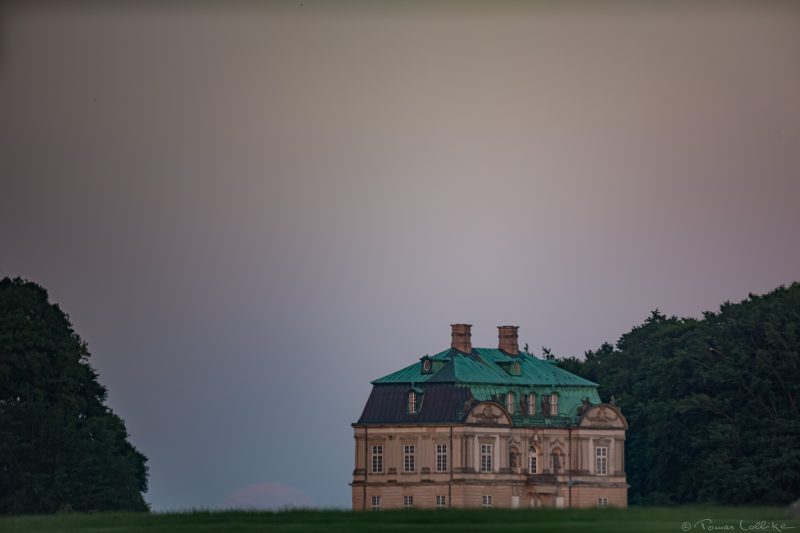
Moon rise exactly where it was calculated to occur!
I checked the result between each exposure and adjusted the exposure times a few times to better capture both the Moon and the surrounding landscape with the castle.
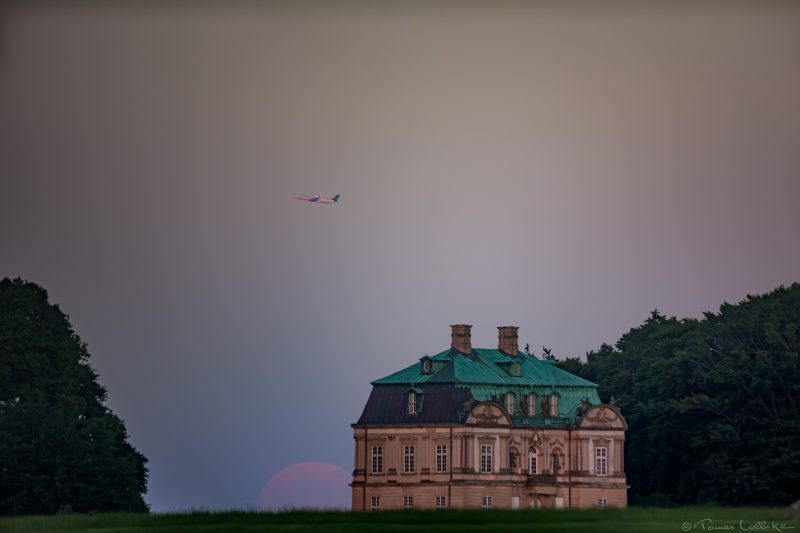
Full Moon rising as planned between woods and castle.
I didn’t notice the airplane until I got home 🙂
At 21:23:29 the Moon was about half way up and had stared to moving behind the castle – I thought it moved faster sideways that up, so I started to get worried that it wouldn’t rise enough to be visible above the roof, but maybe instead be completely hidden until reappearing on the other side of the castle, so I increased the intervals between shots, to at least get something…!
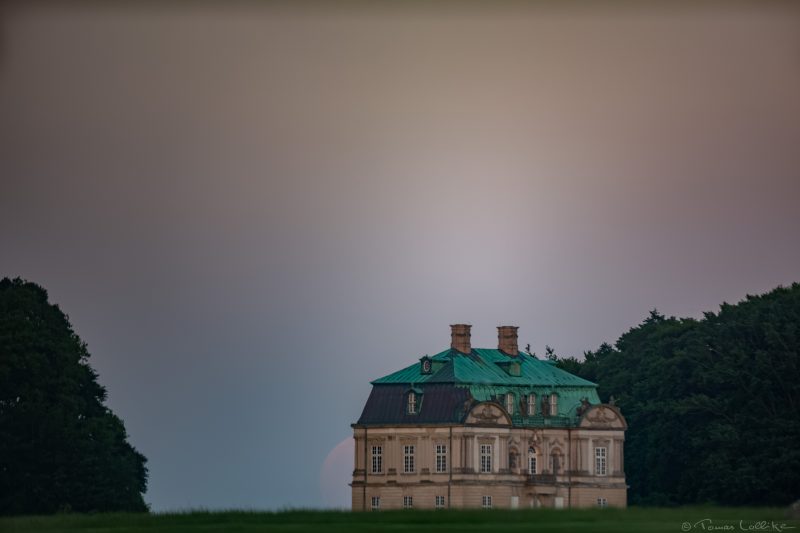
The Moon almost hidden by the castle – should I move my setup?
In the end I didn’t dare to stay, and quickly detached my computer (which was only used for focusing) and moved the telescope 20 meters to the side, to make sure the Moon would rise perfectly up along the photographer’s left side of the castle and stay visible at all times!!
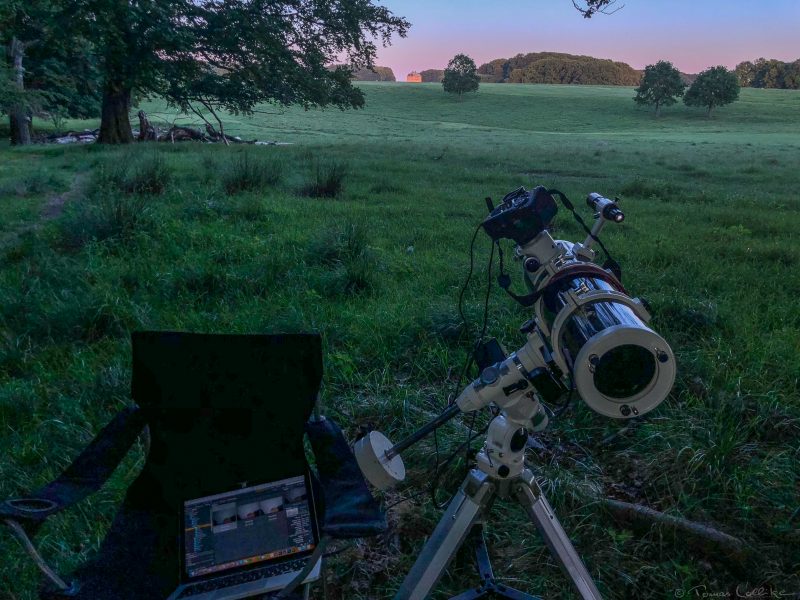
New location after moving the setup a bit
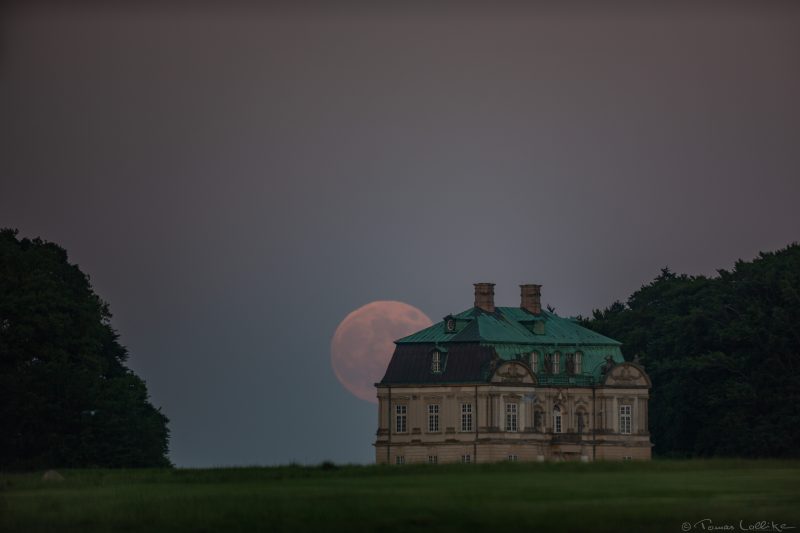
The Moon more visible after moving the setup some 20 meters to the side
At 21:30:11 a couple crossed the golf course and I thought it could have been a cool shot to focus on them and have the castle and the moon unfocussed in the background – but I didn’t dare to move the focus and spend time to refocus afterwards as I didn’t have autofocus at my disposal, so I left the women unfocussed…
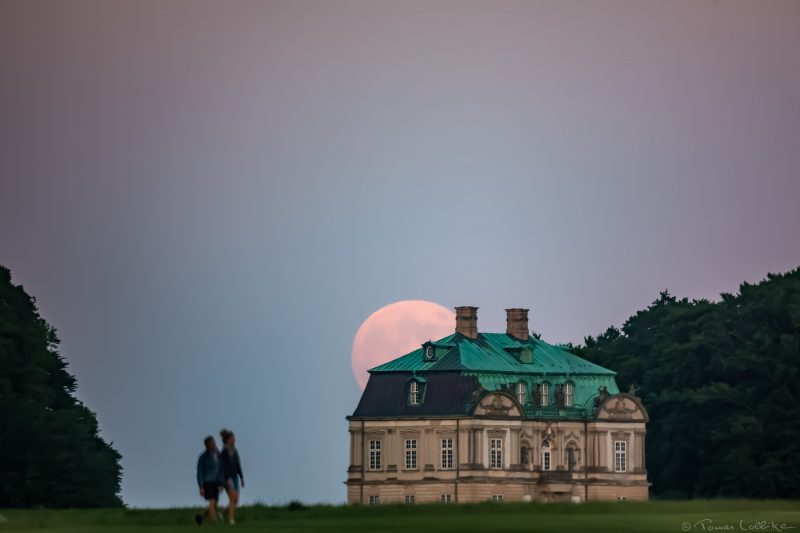
A couple crossing the golf course in front of castle and the rising Moon.
At 21:31:39 the Moon had risen to the top of the roof and was placed perfectly around the chimneys of the castle – it was neat, I thought, however there were some misbalance with empty space on one side of the castle and the woods on the other side…
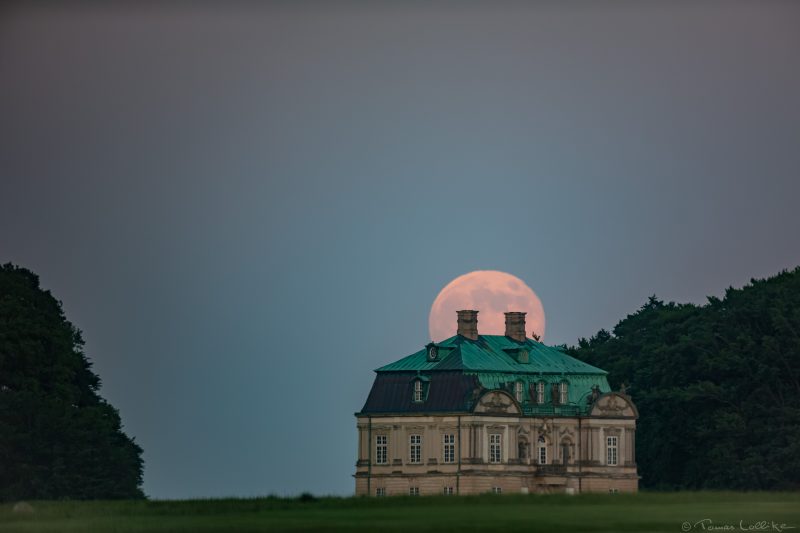
The Full Moon perfectly placed around the chimneys
A crop would be right here – but I have left it full size for the article
Then finally at 21:32:29 the shot was in the box! 😃👏
The Full Moon was still behind the castle, but most of was now visible, and having both the castle and the Full Moon in two of the the Golden Ratio lines made this image my preferred photo of the night!
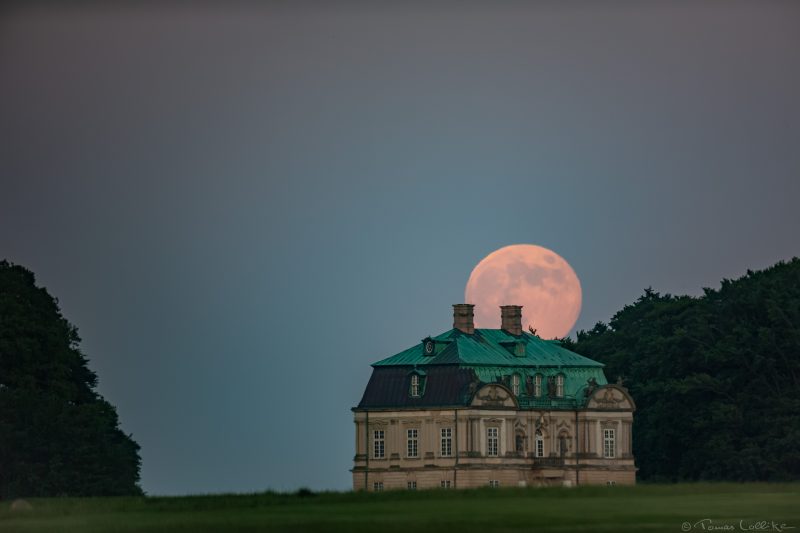
The photo I decided to send to Digital Photo as a Reader’s Monthly Shot
At 21:33:30 the Moon was completely free of the castle, but it continued a nice path just above the tree line of the woods, so I continued shooting a while further, and at 21:35:19 it almost looked like the Moon was a ballon attached to one of the trees.
Finally, by 21:36:04 the Moon was completely free of the woods continuing it’s known path up into the sky and at 21:57 I packed up my gear and headed back to my car.
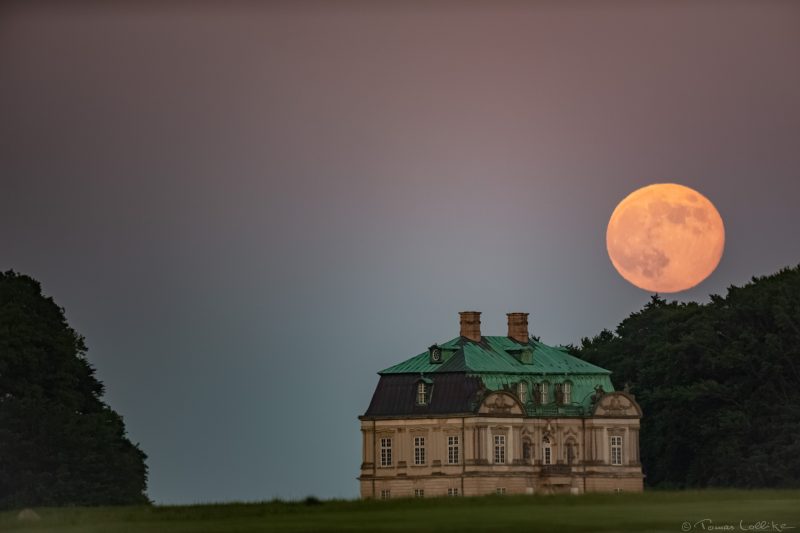
The Full Moon as a ballon attached to the trees
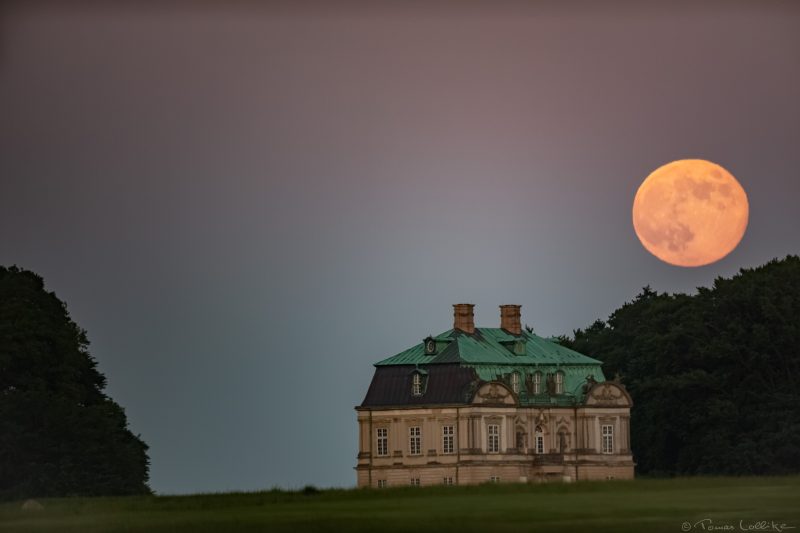
The Full Moon free of the last trees in the woods
Back in the car I started to itch everywhere, and when I was back home the reason was apparent…
…I had gained hundreds of mosquito bites everywhere as I had been dressed in shorts and a t-shirt on this late spring night of May 2018 🙄
As mentioned, I sent in the preferred photo of the night to the Scandinavian magazine Digital Foto, and it was rewarded Readers Shot Of The Month in June 2018 😃
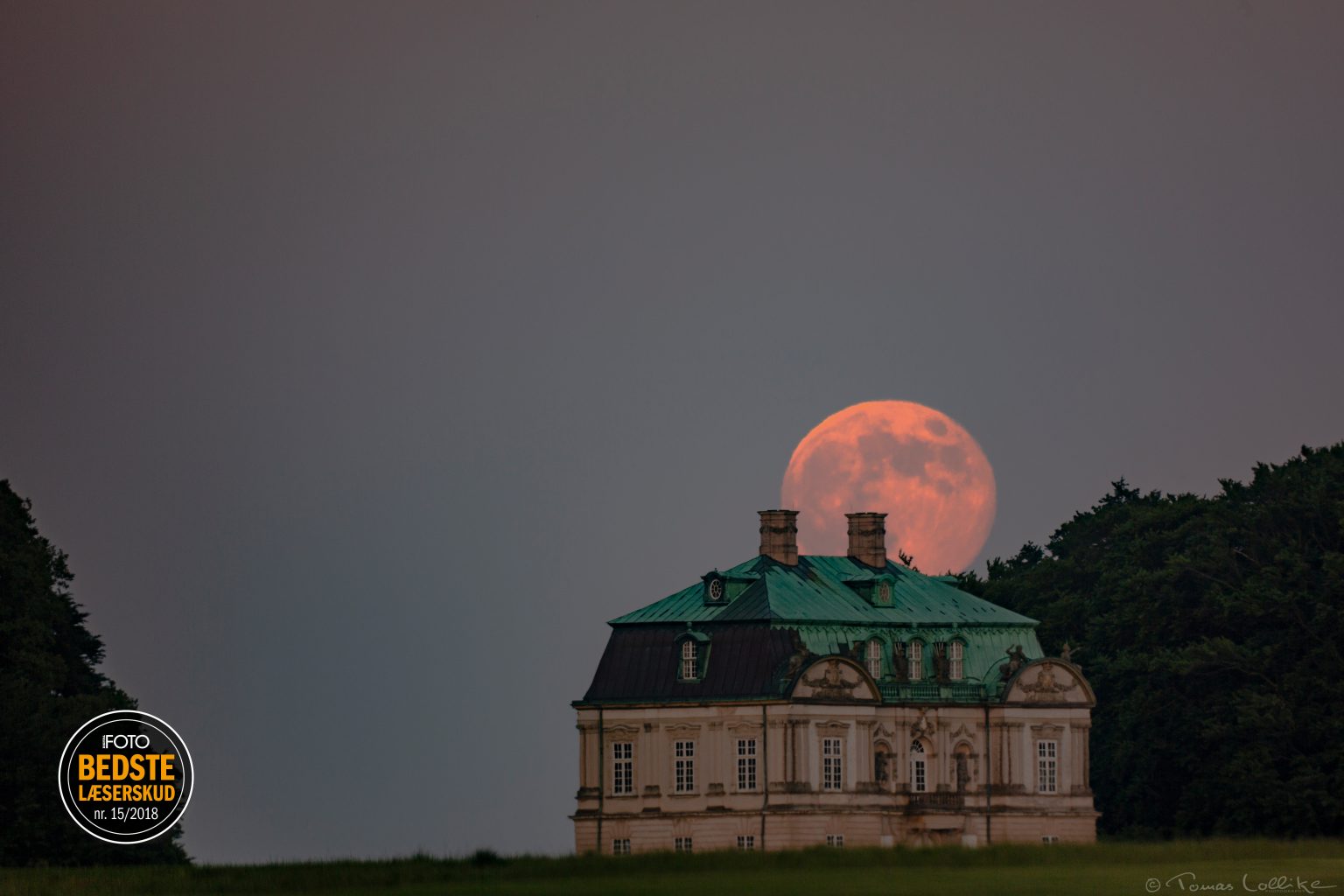
The preferred shot of the day!
The Full Moon of May 2018 rising behind the Danish Royal Hunting Lodge.
It was great to get the acknowledgement in Digital Foto, but the biggest excitement was to see the Moon actually rise over the horizon exactly where planned (and hoped) for – and it felt like a great victory that the idea and the planning, all came together really well – not to mention the clear sky on this beautiful and warm spring evening of May’s Full Moon 2018 👏🔭📸🤩
I was definitely worth all the mosquito bites!!! 🦟🦟🦟
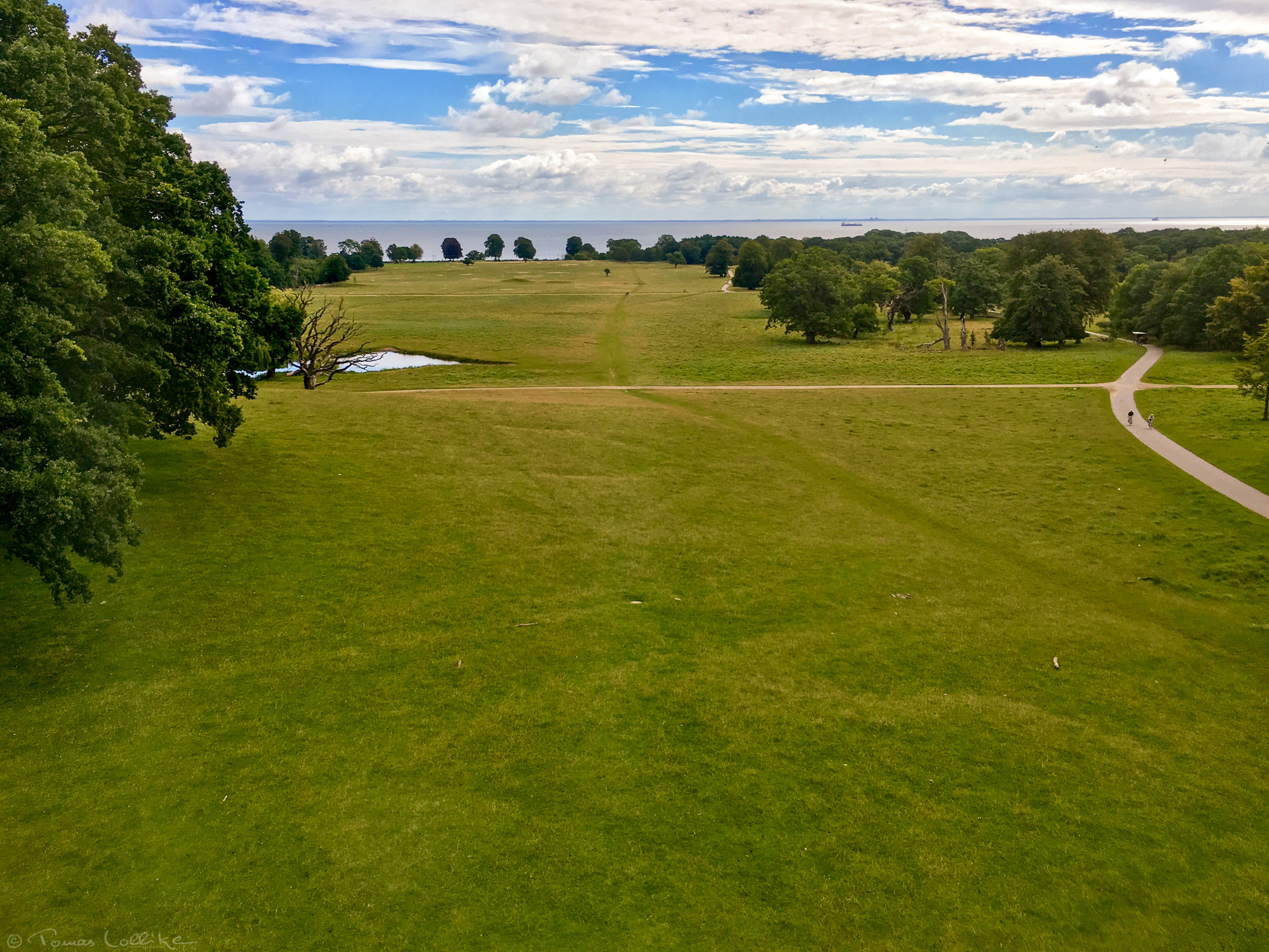
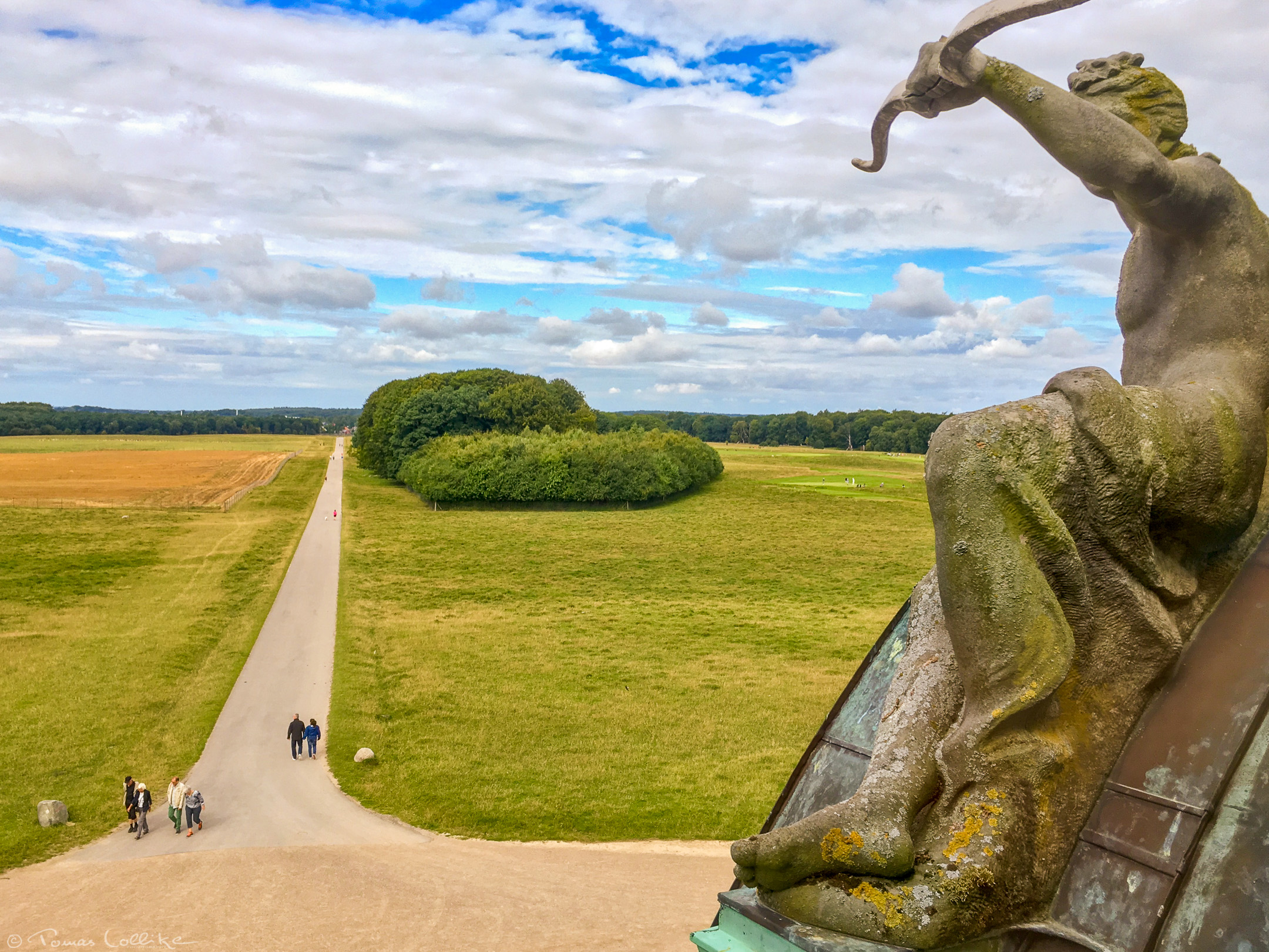
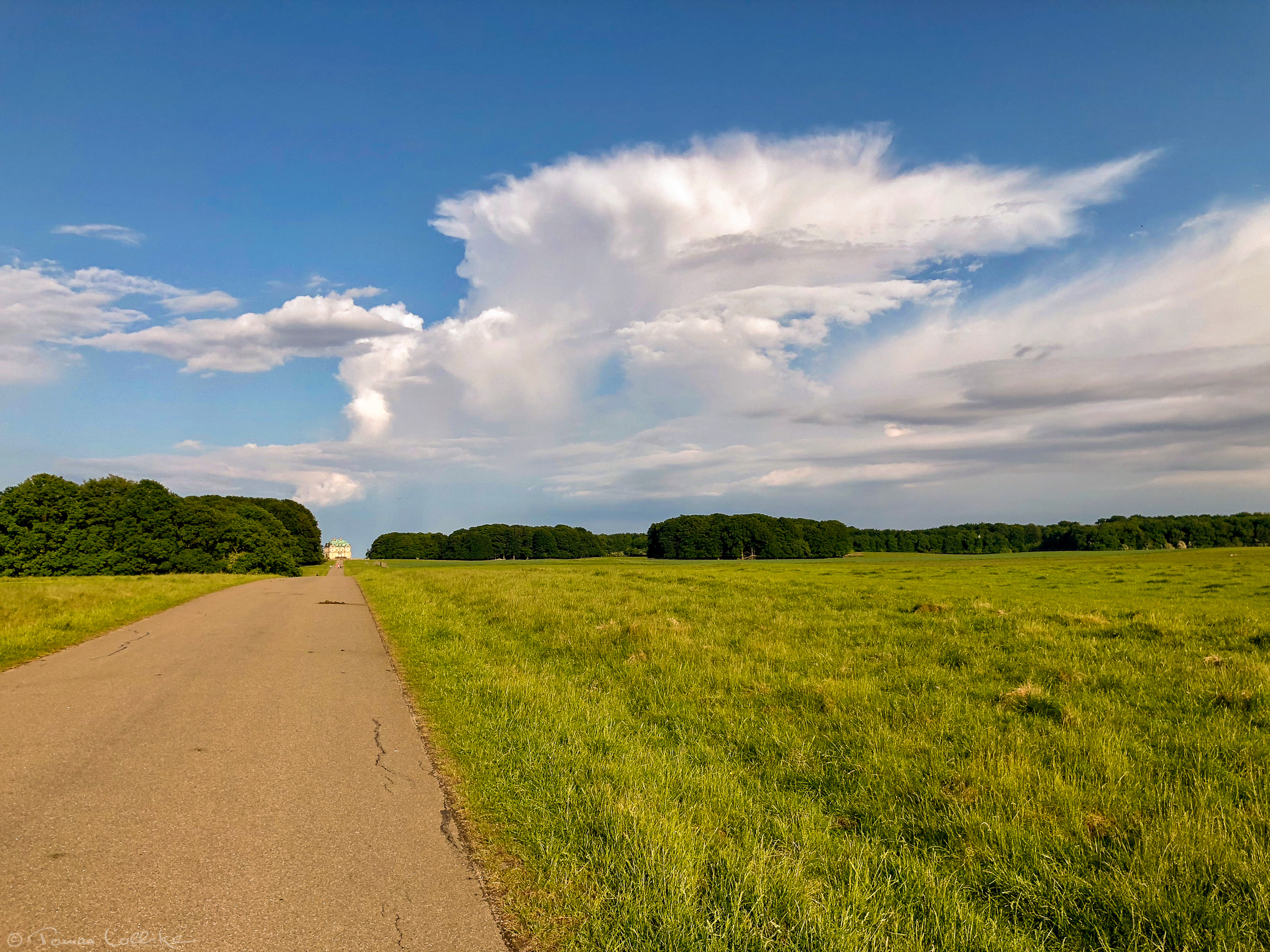
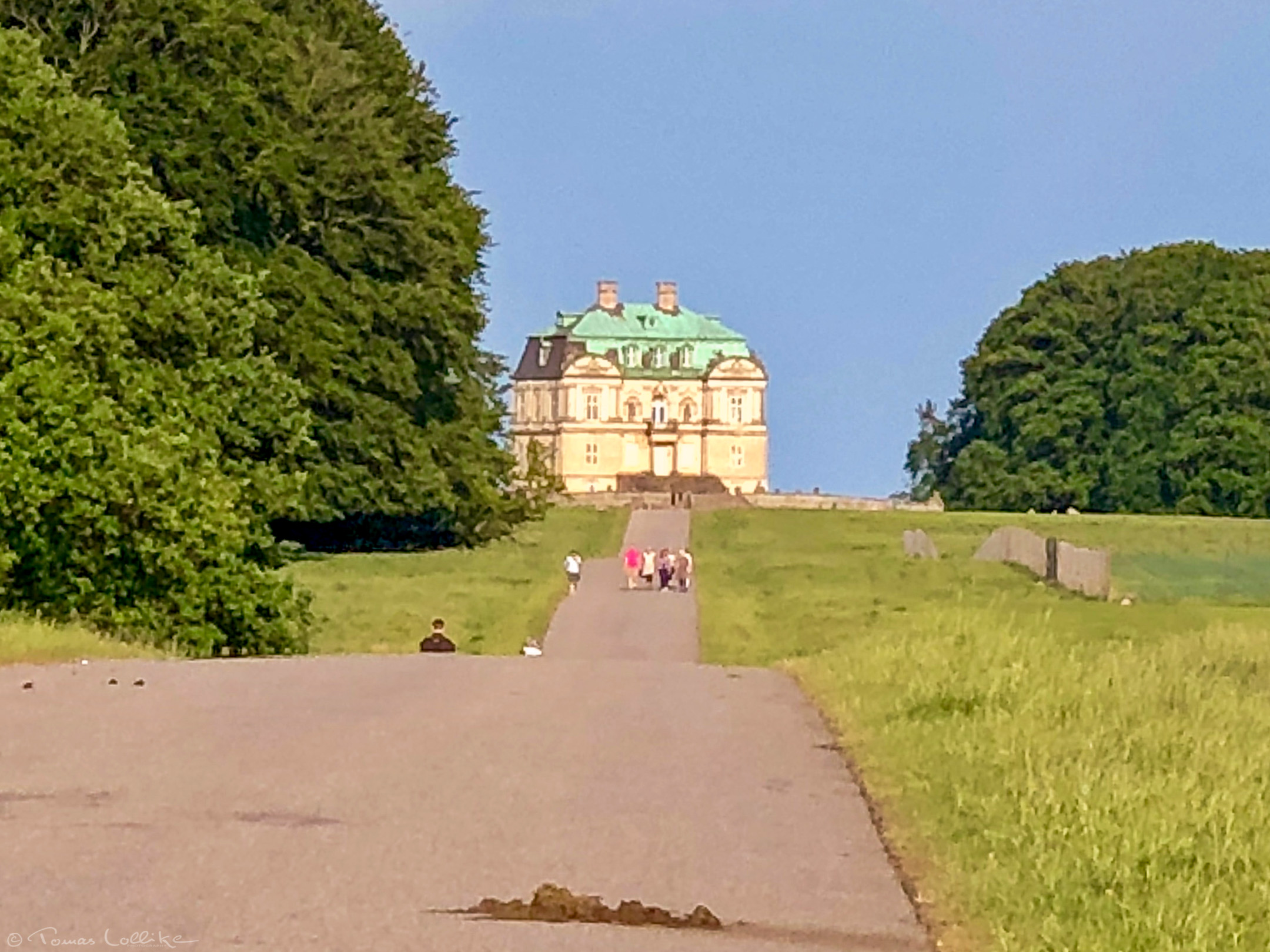
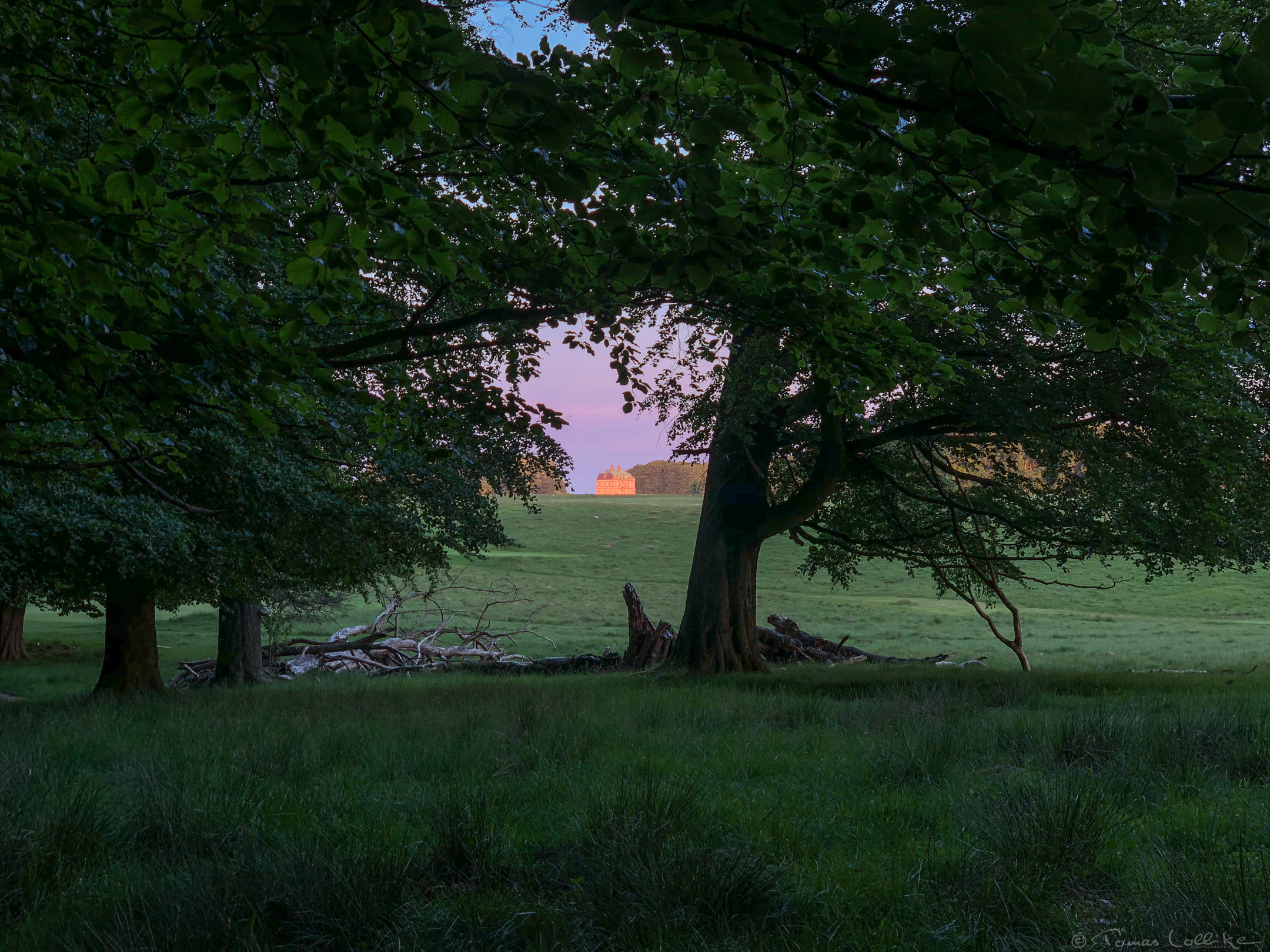
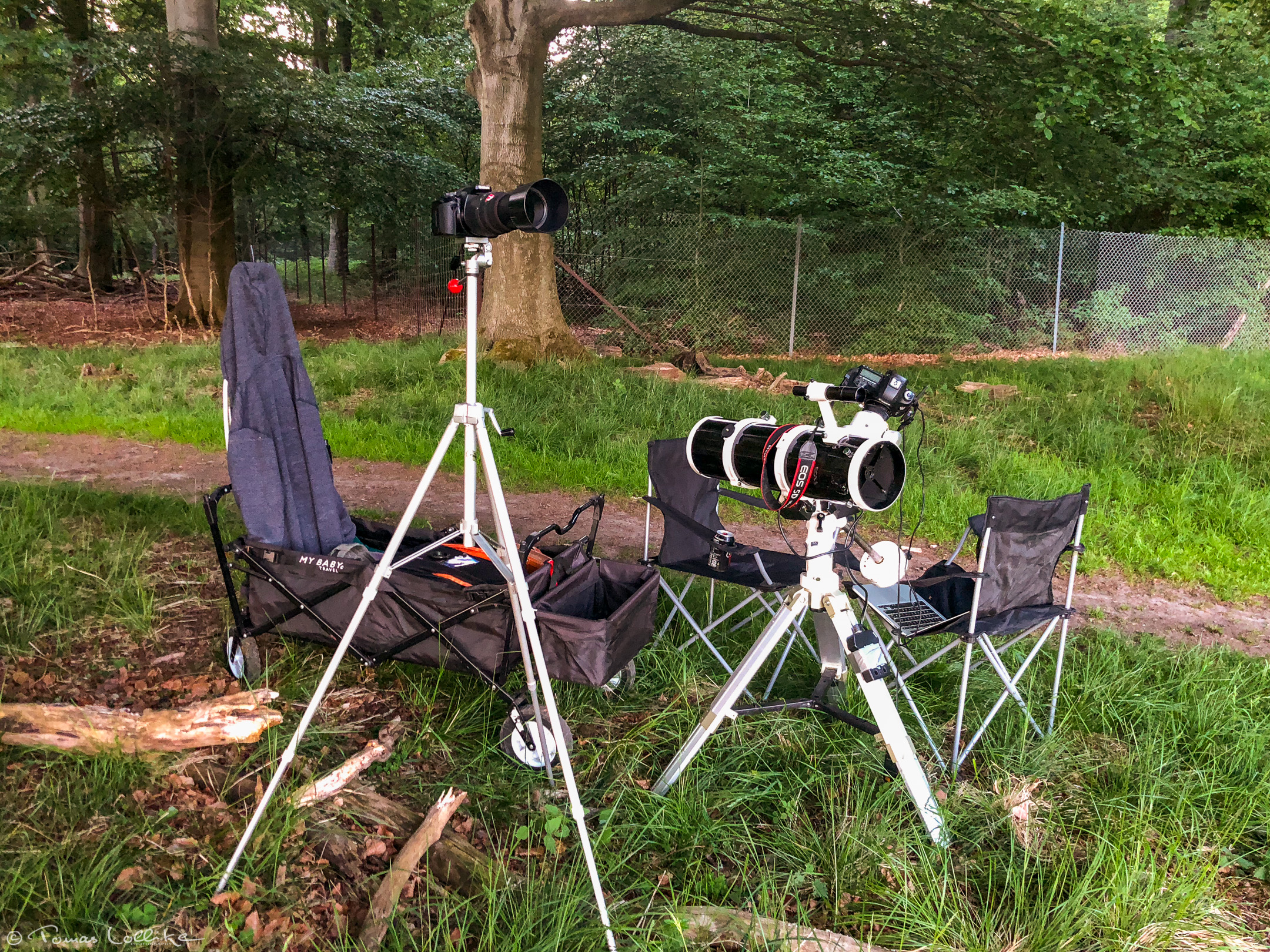


Leave a Reply